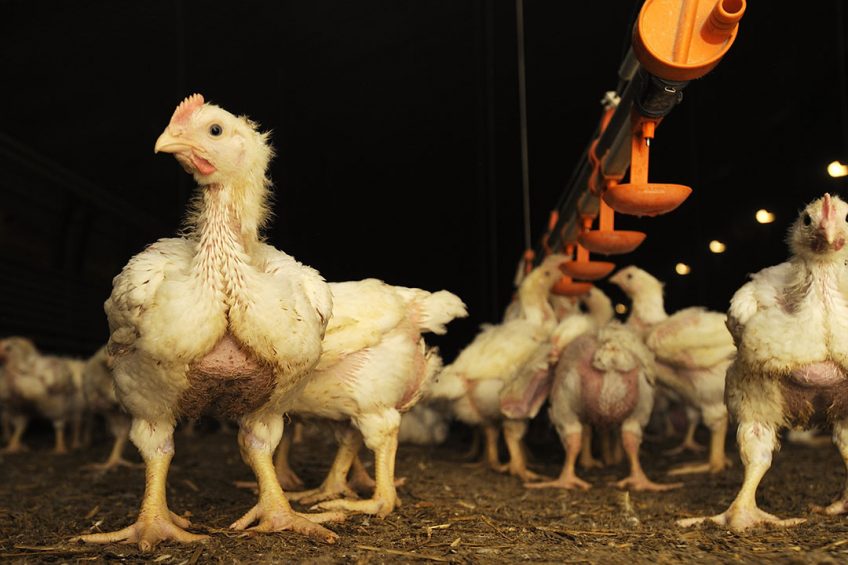Fast growth and high breast yield linked to poor welfare

Bird welfare is compromised when broilers are grown faster for higher breast meat yields
This was discovered by a major 2-year North American study involving 7,500 birds from 16 genetic strains. The analysis, carried out at the University of Guelph, Canada, found that conventional strains of broiler chicks grew faster, more efficiently and had higher breast yields than slower growing strains.
But there were significant trade-offs for this high productivity. In comparison with strains with slower growth rates and lighter breast yields, strains with faster growth rates and higher breast yields had:
- Lower activity levels
- Poorer indicators of mobility
- Poorer foot and hock health
- Higher biochemical markers of muscle damage
- Higher rates of muscle myopathies
- Potentially inadequate organ development
The objective of the study, produced for the welfare organisation Global Animal Partnership, was to understand differences in behaviour, mobility, anatomy, physiology, mortality, feed efficiency and carcass and meat quality as they relate to the stains’ growth rates. Strains were categorised based on average daily gain to 3.2kg with conventional strains adding more than 62g/day; fastest slow strains (53-55g/day); moderate slow strains (50-51g/day); and slowest strains (43-47g/day). Within the same experimental room, strains were reared over 8 trials and housed in identical pens at 30kg/square metre (placement of 44 birds/pen) with enrichments that facilitated physical and oral activity.
Broiler welfare was studied by considering whether they might be experiencing pain or poor health, and whether they can perform motivated behaviour. Pain thresholds were examined through the birds’ general behaviour and activity levels, through mobility tests and presence of footpad lesions and hock burns. The fastest growing strains spent more time sitting, and less time standing and walking than slower strains, even at the same stages.
 Effect of transport distance and climate on broilers
Effect of transport distance and climate on broilers
Researchers looked in to the effect of transport distance on commercial broiler chickens at distances of 15 km to 90 km.
26 Days of Age:
Conventional: Birds of this strain spent 73.6% of their time sitting, 4.2% standing and 2.3% walking. Other strains: These birds spent 63% of their time sitting, 7.8% standing and 4.3% walking. All birds decreased their use of enrichments with age, but the slow strains used the enrichments more than faster growing strains of all ages.
Foot pad lesion scores
An obstacle test to evaluate broilers’ ability or motivation to cross a physical barrier to access feed and water found that over a 5-hour period the conventional and fastest slow strains crossed the obstacle fewer times than slow strains. This difference may indicate differences in functional leg strength that may limit the fastest growing stains from accessing important resources. The conventional and slowest growing strains had the worst footpad lesion scores.
 KFC: Findings of chicken welfare audit UK and Ireland
KFC: Findings of chicken welfare audit UK and Ireland
Welfare experts have worked with fast food restaurant chain KFC UK and Ireland to produce a first welfare report.
These lesions relate to poor litter conditions, influenced by different behaviour patterns. For the conventional strains, their high feed intake and excreta output couple with low activity levels caused poor litter conditions. For slow strains, their use of enrichments (including perching on the drinker lines) may have caused water leakage and inconsistent litter conditions. The conventional and fastest slow growing strains had the worst hock burn scores, which relate to the time spent sitting on wet litter. In general, growth rate reduced activity levels, mobility and interactions with environmental enrichments, and was related to increased footpad lesions and hock burns.
When looking at broilers’ health, the study found no effect of growth rate on mortality and there were no disease outbreaks, despite the use of an antibiotic-free diet. Overall mortality rate in the trial was 2.52%. There were also few indicators of ascites or bone quality issues, such as tibial dyschondroplasia and long bone deformities, indicating the successful incorporation of these factors into selection indices across the strains. The conventional strains had the strongest tibiae.
 Tibial dyschondroplasia (TD)
Tibial dyschondroplasia (TD)
Find out more about the causes and effects of TD and many other poultry diseases in our health tool.
Dr Tina Widowski, co-lead researcher at the University of Guelph, said: “This study was the first multi-disciplinary research project of chicken welfare to include carefully chosen indicators such as behaviour, physiology, anatomy, production and meat quality together into one research project. No other broiler chicken research project has been carried out on this scale.” Anne Malleau, Global Animal Partnership (GAP) executive director, said the study would make a significant contribution to the scientific literature across many fields, and would play a pivotal role in “pursuing a better broiler.”
It is part of GAPs Better Chicken Project, which brings scientists, breeding companies, producers, buyers and animal welfare advocates together to establish a research-based framework for the modern broiler.
The study received in-kind contributions from the Ontario Agri-Food Innovation Alliance and the major poultry genetic companies and was designed and conducted independently.












